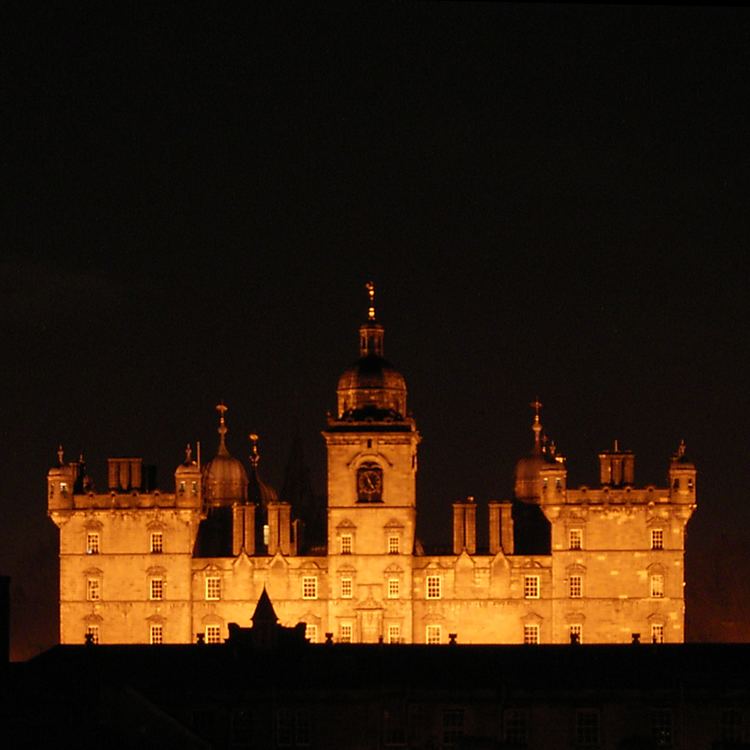Head of the Senior School Mr Robert Dickson Chairman of Governors Mr Michael Gilbert | Principal Mr Cameron Wyllie Head of the Junior School Mrs Lesley Franklin Phone +44 131 229 7263 Date founded 1628 | |
 | ||
Motto "Impendo"; ("I Distribute Chearfullie") Similar Fettes College, George Watson's College, Stewart's Melville College, The Edinburgh Academy, Merchiston Castle School - E | ||
George heriot s school cup song
George Heriot's School is a Scottish independent primary and secondary school on Lauriston Place in the Old Town of Edinburgh, Scotland, with over 1600 pupils, 155 teaching staff and 80 non-teaching staff. It was established in 1628 as George Heriot's Hospital, by bequest of the royal goldsmith George Heriot, and opened in 1659.
Contents
- George heriot s school cup song
- Micro tyco george heriot s school
- Architecture
- History
- Headmasters
- Houses
- Extra curricular activities
- Notable alumni
- References
Micro tyco george heriot s school
Architecture
The main building of the school is notable for its renaissance architecture, the work of William Wallace, until his death in 1631. He was succeeded as master mason by William Aytoun, who was succeeded in turn by John Mylne. In 1676, Sir William Bruce drew up plans for the completion of Heriot's Hospital. His design, for the central tower of the north façade, was eventually executed in 1693.
The school is a turreted building surrounding a large quadrangle, and built out of sandstone. The foundation stone is inscribed with the date 1628. The intricate decoration above each window is unique (with one paired exception - those on the ground floor either side of the now redundant central turret on the west side of the building). A statue of the founder can be found in a niche on the north side of the quadrangle.
The main building was the first large building to be constructed outside the Edinburgh city walls. It sits next to Greyfriars Kirk, built in 1620, in open grounds overlooked by Edinburgh Castle directly to the north. Parts of the seventeenth-century city wall (the Telfer Wall) serve as the walls of the school grounds. When built the building's front facade faced the entrance on the Grassmarket. It was originally the only facade fronted in fine ashlar stone, the others being harled rubble, but in 1833 the three rubble facades were refaced in Craigleith ashlar stone. This was done as the other facades had become more visible with the new entrance on Lauriston Place. The refacing work was handled by Alexander Black the then Superintendent of Works for the school, who later designed the first Heriot's free schools around the city.
The north gatehouse onto Lauriston Place is by William Henry Playfair and dates from 1829. The chapel interior is by James Gillespie Graham (1837) who is likely to have been assisted by Augustus Pugin. The school hall was designed by Donald Gow in 1893 and boasts a hammerbeam roof above the later mezzanine floor. The chemistry block to the west of the site was designed by John Anderson in 1911. The science block is by John Chesser (architect) and dates from 1887 incorporating part of the former primary school of 1838 by Alexander Black (architect).
The grounds contain a selection of other buildings of varying age; these include a wing by inter-war school specialists Reid & Forbes, a swimming pool, now unused, and a granite war memorial, by James Dunn (1922) dedicated to the school's former pupils and teachers who died in World War I and World War II.
History
On his death in 1624, George Heriot left around 25,000 Pound Scots – equivalent to several tens of millions today – to found a "hospital" (then the name for this kind of charitable school) to care for the "puir, faitherless bairns" (Scots: poor, fatherless children) of Edinburgh.
The construction of Heriot's Hospital (as it was first called) was begun in 1628, just outside the city walls of Edinburgh. It was completed just in time to be occupied by Oliver Cromwell's English forces during the invasion of Scotland during the Third English Civil War; the building was used as a barracks, with horses stabled in the chapel.
The hospital opened in 1659, with thirty sickly children in residence; its finances grew, and it took in other pupils in addition to the orphans for whom it was intended. In the 1880s, it began to charge fees; however, to this day it serves its charitable object, providing free education to fatherless children, referred to as "foundationers". In 1846 there was an insurrection in the hospital and fifty-two boys were dismissed.
In 1837 the school founded ten "free schools" in Edinburgh, educating several thousand pupils across the city; these were closed in 1885. One of them, with a copy of several of the features of the original Lauriston Place building, is at the east end of the Cowgate (now serving as a Salvation Army hostel).
The school also provided funds for the establishment of an institution which later merged with the Watt Institution (named after James Watt) in the 1870s to form Heriot-Watt College, a technical college that became Heriot-Watt University in 1966.
In 1979 it became co-educational with the arrival of the first girls, and now has around 1600 pupils. Today, the school is Edinburgh's best performing school by Higher exam results with leavers (in 2014) attending the country's most selective and prestigious universities including St Andrews (31), Glasgow (26) and Edinburgh (14) in Scotland and Oxford (2), Cambridge (4), Bristol (4) and King's College London (3) in England.
Headmasters
Chronological list of the headmasters of the school, the year given being the one in which they took office.
Thereafter, the title of Headmaster was changed to that of Principal.
Houses
Pupils at the school belong to one of four houses:
Extra-curricular activities
George Heriot's School has a wide range of extra-curricular activities in which pupils participate.
